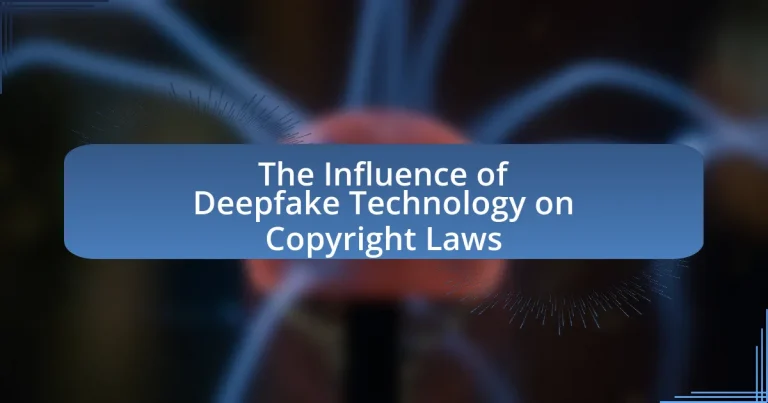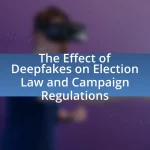Deepfake technology significantly impacts copyright laws by challenging established concepts of authorship and ownership. This technology enables the creation of realistic synthetic media that can replicate individuals’ likenesses and voices without consent, leading to potential copyright infringements and legal disputes. The article explores how deepfakes complicate existing copyright frameworks, the legal definitions surrounding copyright in relation to deepfakes, and the risks faced by content creators and copyright holders. It also examines current legal responses, proposed legislation, and the evolving landscape of copyright law as it adapts to the challenges posed by deepfake technology.
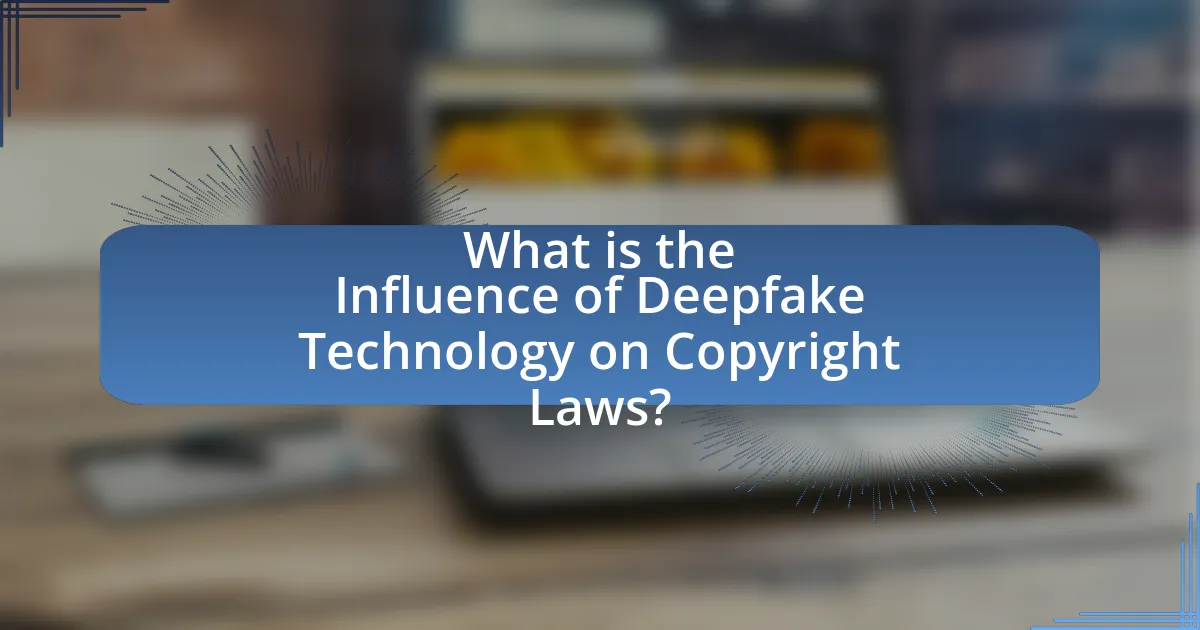
What is the Influence of Deepfake Technology on Copyright Laws?
Deepfake technology significantly influences copyright laws by challenging traditional notions of authorship and ownership. This technology allows for the creation of hyper-realistic synthetic media, which can replicate the likeness and voice of individuals without their consent, raising questions about the rights of individuals versus the rights of creators. For instance, the unauthorized use of someone’s image in a deepfake can infringe on their copyright and personality rights, leading to legal disputes. Additionally, existing copyright frameworks may not adequately address the complexities introduced by deepfakes, as they blur the lines between original content and derivative works. As a result, lawmakers are increasingly called to adapt copyright laws to better protect individuals from misuse while balancing the interests of creators in the digital landscape.
How does deepfake technology challenge existing copyright frameworks?
Deepfake technology challenges existing copyright frameworks by enabling the unauthorized use and manipulation of copyrighted materials, such as images and videos, without the consent of the original creators. This technology allows individuals to create realistic alterations of media, which can infringe on the rights of copyright holders by misrepresenting their work or likeness. For instance, deepfakes can generate content that appears to feature celebrities or public figures, potentially leading to legal disputes over the ownership and control of their likenesses. The rapid advancement of deepfake capabilities outpaces current copyright laws, which often do not account for the complexities of digital manipulation and the potential for misuse, thereby creating a legal gray area that complicates enforcement and protection of intellectual property rights.
What are the legal definitions of copyright in relation to deepfakes?
Copyright law defines the exclusive rights of creators over their original works, which can include audiovisual content manipulated by deepfake technology. In the context of deepfakes, copyright issues arise when the technology is used to create altered representations of copyrighted material without permission from the original creator. For instance, if a deepfake uses a copyrighted video or audio clip, it may infringe on the copyright holder’s rights, as the original work is still protected under copyright law. Courts have begun to address these issues, emphasizing that the unauthorized use of copyrighted material in deepfakes can lead to legal consequences, including potential lawsuits for copyright infringement.
How do deepfakes create potential copyright infringements?
Deepfakes create potential copyright infringements by using copyrighted images, videos, or audio without permission to generate misleading or unauthorized content. This unauthorized use can violate the rights of original creators, as deepfakes often replicate the likeness or voice of individuals without consent, leading to potential legal claims under copyright law. For instance, a study by the Electronic Frontier Foundation highlights that deepfakes can exploit the intellectual property of actors or musicians, thereby infringing on their exclusive rights to control the use of their personas.
Why is it important to understand the implications of deepfake technology on copyright?
Understanding the implications of deepfake technology on copyright is crucial because it challenges traditional notions of authorship and ownership in digital content. Deepfakes can manipulate existing media, creating new works that may infringe on the rights of original creators, leading to potential legal disputes. For instance, the U.S. Copyright Office has noted that unauthorized use of copyrighted material in deepfakes raises questions about fair use and the extent of protection for original works. This evolving landscape necessitates a clear understanding of how copyright laws adapt to address the unique challenges posed by deepfake technology, ensuring that creators’ rights are upheld while fostering innovation in digital media.
What are the potential risks for content creators and copyright holders?
Content creators and copyright holders face significant risks due to deepfake technology, primarily including unauthorized use of their work, reputational damage, and legal challenges. Unauthorized use occurs when deepfakes replicate or manipulate original content without permission, leading to potential financial losses and infringement claims. Reputational damage arises when deepfakes misrepresent creators or their work, potentially harming their brand and audience trust. Legal challenges can stem from the difficulty in enforcing copyright laws against deepfake creators, as current legislation may not adequately address the nuances of this technology, leaving copyright holders vulnerable to exploitation.
How can deepfake technology affect the distribution of copyrighted material?
Deepfake technology can significantly undermine the distribution of copyrighted material by enabling the creation of realistic but unauthorized reproductions of original works. This technology allows individuals to manipulate video and audio content, making it possible to produce counterfeit versions of copyrighted material without the consent of the original creators. For instance, a study by the University of California, Berkeley, found that deepfake videos can be indistinguishable from real footage, raising concerns about intellectual property rights and the potential for widespread copyright infringement. As a result, the ease of creating and distributing deepfakes poses a challenge to existing copyright laws, which may struggle to address the complexities introduced by such advanced manipulation techniques.
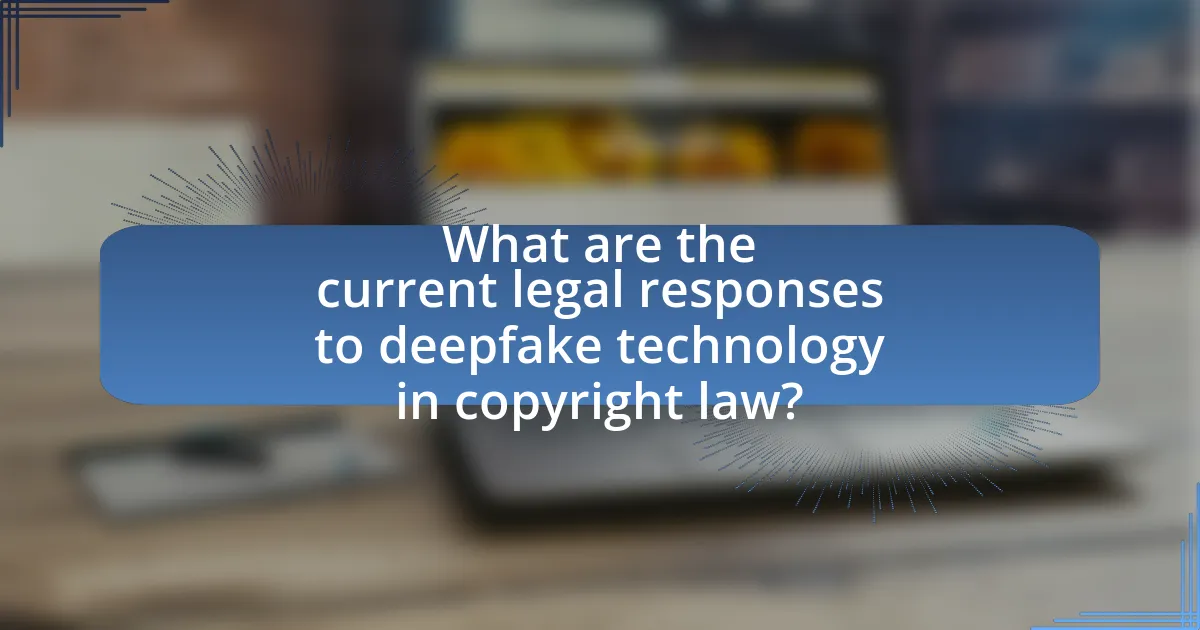
What are the current legal responses to deepfake technology in copyright law?
Current legal responses to deepfake technology in copyright law include the adaptation of existing copyright frameworks and the introduction of new legislation aimed at addressing the unique challenges posed by deepfakes. For instance, the U.S. Copyright Office has acknowledged the potential for deepfakes to infringe on copyright by misappropriating original works, leading to discussions about the need for clearer guidelines on authorship and ownership in the context of AI-generated content. Additionally, some states, such as California, have enacted laws specifically targeting the malicious use of deepfake technology, which can intersect with copyright issues by protecting individuals from unauthorized use of their likeness in deepfake creations. These legal measures reflect an evolving understanding of how copyright law must adapt to technological advancements like deepfakes.
How are lawmakers addressing the challenges posed by deepfakes?
Lawmakers are addressing the challenges posed by deepfakes through the introduction of legislation aimed at regulating their use and mitigating potential harms. For instance, several states in the U.S. have enacted laws that criminalize the malicious use of deepfake technology, particularly in contexts such as election interference and non-consensual pornography. Additionally, the proposed DEEPFAKES Accountability Act seeks to require disclosure when deepfakes are used in media, thereby enhancing transparency and accountability. These legislative efforts are supported by growing concerns over the potential for deepfakes to undermine trust in information and harm individuals’ reputations.
What new legislation has been proposed or enacted regarding deepfakes?
Recent legislation regarding deepfakes includes the introduction of the “Malicious Deep Fake Prohibition Act” in the United States Congress, which aims to criminalize the use of deepfake technology for malicious purposes, such as defamation or fraud. This act reflects growing concerns over the potential misuse of deepfake technology, particularly in the context of misinformation and privacy violations. Additionally, several states, including California and Texas, have enacted laws that specifically address the creation and distribution of deepfakes, particularly in relation to non-consensual pornography and election interference. These legislative efforts underscore the urgent need to regulate deepfake technology to protect individuals and maintain the integrity of information.
How do courts interpret existing copyright laws in cases involving deepfakes?
Courts interpret existing copyright laws in cases involving deepfakes by assessing whether the use of copyrighted material in the deepfake constitutes fair use or infringement. In several instances, courts have applied the four-factor fair use test, which considers the purpose of the use, the nature of the copyrighted work, the amount used, and the effect on the market for the original work. For example, in the case of “Gordon v. Google,” the court ruled that the transformative nature of the deepfake could potentially qualify for fair use, depending on the specific circumstances. This interpretation reflects a growing recognition of the complexities introduced by deepfake technology in copyright law, as courts navigate the balance between protecting original creators and addressing new forms of content creation.
What role do international copyright laws play in the context of deepfakes?
International copyright laws play a crucial role in regulating the use and distribution of deepfakes by establishing ownership rights over original content. These laws determine whether the creators of deepfake technology can legally use copyrighted materials, such as images or videos, without permission from the original copyright holders. For instance, the Berne Convention and the Agreement on Trade-Related Aspects of Intellectual Property Rights (TRIPS) set international standards for copyright protection, which can be invoked in cases where deepfakes infringe on the rights of original content creators. This legal framework helps to address potential abuses of deepfake technology, such as unauthorized likenesses or misrepresentation, thereby protecting the intellectual property rights of individuals and organizations.
How do different countries approach copyright issues related to deepfake technology?
Different countries approach copyright issues related to deepfake technology through varying legal frameworks and regulations. In the United States, the Digital Millennium Copyright Act (DMCA) addresses copyright infringement but does not specifically mention deepfakes, leading to ongoing debates about liability and fair use. In contrast, the European Union has proposed regulations that explicitly consider deepfake technology, emphasizing the need for transparency and accountability in content creation. Countries like China have implemented strict laws against the misuse of deepfake technology, focusing on protecting personal rights and preventing misinformation. These diverse approaches reflect each country’s legal priorities and cultural attitudes toward copyright and technology.
What are the challenges of enforcing copyright laws across borders with deepfakes?
Enforcing copyright laws across borders with deepfakes presents significant challenges due to jurisdictional discrepancies, technological complexity, and the anonymity of creators. Jurisdictional discrepancies arise because different countries have varying copyright laws, making it difficult to apply a uniform standard to deepfake content that may violate copyright. Technological complexity complicates enforcement, as deepfakes can be easily created and distributed online, often obscuring the original source and making it hard to identify infringers. Additionally, the anonymity of creators, facilitated by the internet, allows individuals to produce and share deepfakes without revealing their identity, further complicating legal actions against copyright infringement. These factors collectively hinder effective enforcement of copyright laws in the context of deepfake technology.
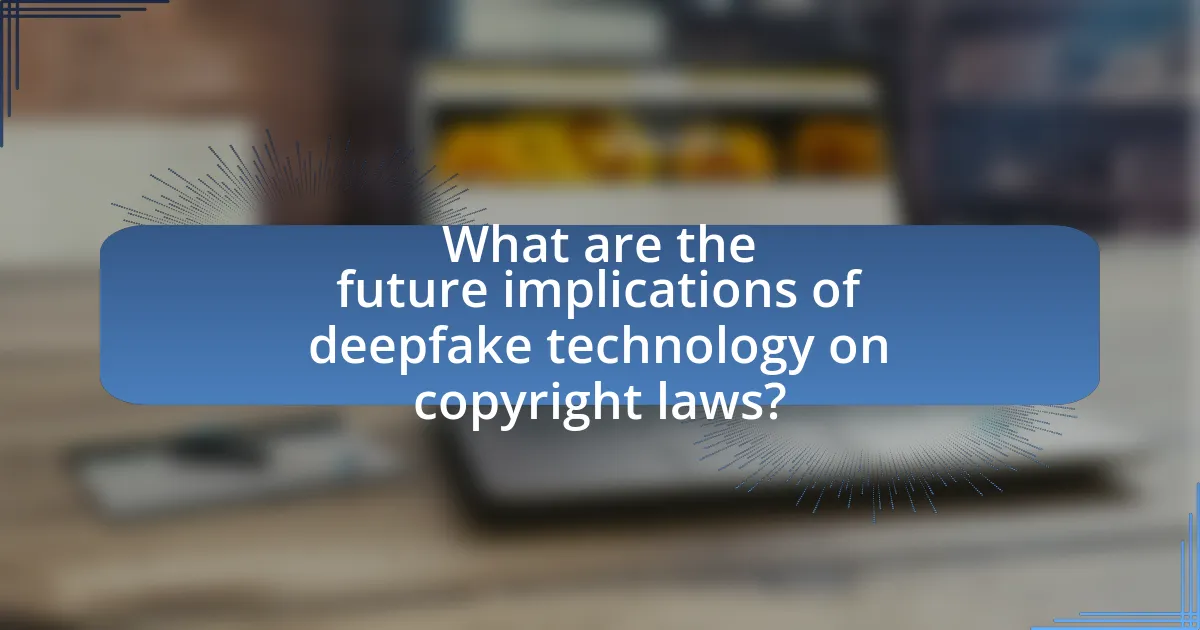
What are the future implications of deepfake technology on copyright laws?
Deepfake technology will likely challenge existing copyright laws by complicating the attribution of authorship and ownership of digital content. As deepfakes can manipulate and recreate copyrighted material without the original creator’s consent, this raises questions about the legality of using such altered content. For instance, the U.S. Copyright Office has acknowledged that the use of deepfake technology could infringe on the rights of original creators, as unauthorized reproductions may not fall under fair use provisions. Additionally, the potential for deepfakes to mislead audiences could prompt lawmakers to revise copyright frameworks to address the unique challenges posed by this technology, ensuring that creators are protected while also considering the implications for free expression and innovation.
How might deepfake technology evolve and impact copyright in the coming years?
Deepfake technology is likely to evolve by becoming more sophisticated and accessible, which will significantly challenge existing copyright laws. As algorithms improve, the ability to create realistic deepfakes will increase, leading to potential misuse in creating unauthorized reproductions of copyrighted material. For instance, in 2022, a report by the European Union Intellectual Property Office highlighted that the rise of AI-generated content, including deepfakes, complicates the enforcement of copyright protections. This evolution may prompt lawmakers to adapt copyright frameworks to address the unique challenges posed by deepfakes, such as defining ownership rights for AI-generated works and establishing liability for misuse.
What trends are emerging in the intersection of technology and copyright law?
Emerging trends at the intersection of technology and copyright law include the increasing challenges posed by deepfake technology, which raises significant concerns regarding intellectual property rights and authenticity. As deepfakes become more sophisticated, copyright law is evolving to address issues related to the unauthorized use of copyrighted material in creating misleading or deceptive content. For instance, courts are beginning to consider how existing copyright frameworks apply to the manipulation of digital media, leading to potential reforms aimed at protecting original creators while balancing the rights of users. Additionally, legislative bodies are exploring new regulations specifically targeting the misuse of deepfake technology, reflecting a growing recognition of the need for legal frameworks that can adapt to rapid technological advancements.
How can copyright laws adapt to keep pace with advancements in deepfake technology?
Copyright laws can adapt to advancements in deepfake technology by incorporating specific provisions that address the unique challenges posed by synthetic media. These adaptations may include defining the ownership of digitally altered content, establishing liability for unauthorized use of an individual’s likeness, and creating clear guidelines for fair use in the context of deepfakes. For instance, the U.S. Copyright Office has acknowledged the need for updated regulations to protect creators while balancing the rights of individuals whose images may be manipulated. This recognition is crucial as deepfake technology continues to evolve, necessitating legal frameworks that can effectively address issues of consent, attribution, and potential harm associated with the misuse of such technology.
What best practices can content creators adopt to protect their copyrights in the age of deepfakes?
Content creators can protect their copyrights in the age of deepfakes by implementing several best practices. First, they should watermark their original content to establish ownership and deter unauthorized use. Watermarks serve as a visual reminder of copyright and can help in identifying the original creator. Second, creators should utilize digital rights management (DRM) tools to control how their content is distributed and accessed, which can prevent unauthorized reproductions. Third, they should register their works with copyright offices, as this provides legal proof of ownership and can enhance enforcement options in case of infringement. Additionally, creators can monitor the internet for unauthorized use of their content through services that track digital usage, allowing them to take timely action against violations. These practices are essential as deepfake technology complicates the landscape of copyright enforcement, making proactive measures crucial for safeguarding intellectual property.
How can creators leverage technology to safeguard their intellectual property?
Creators can leverage technology to safeguard their intellectual property by utilizing digital rights management (DRM) systems, blockchain technology, and watermarking techniques. DRM systems restrict unauthorized access and distribution of digital content, ensuring that creators maintain control over their work. Blockchain technology provides a decentralized ledger that can verify ownership and track the usage of intellectual property, making it difficult for infringers to claim ownership. Watermarking techniques embed identifiable information within digital content, allowing creators to prove ownership and trace unauthorized use. These technological solutions enhance the protection of intellectual property rights in an increasingly digital landscape.
What strategies can be implemented to mitigate risks associated with deepfakes?
To mitigate risks associated with deepfakes, implementing robust detection technologies is essential. These technologies utilize machine learning algorithms to identify inconsistencies in videos and audio that indicate manipulation. For instance, research from the University of California, Berkeley, demonstrates that deepfake detection systems can achieve over 90% accuracy by analyzing pixel-level discrepancies and audio-visual synchronization. Additionally, establishing legal frameworks that classify deepfakes as a form of fraud can deter malicious use. Countries like the United States and the European Union are already considering legislation to address the misuse of deepfake technology, reinforcing accountability for creators. Public awareness campaigns also play a crucial role, educating individuals about the existence and potential dangers of deepfakes, thereby fostering critical consumption of media.
